|
All Global Research articles can be read in 51 languages by activating the “Translate Website” drop down menu on the top banner of our home page (Desktop version).
Visit and follow us on Instagram at @crg_globalresearch.
Revised, May 10, 2021
***
The Kent State community commemorated the 51st anniversary of the May 4, 1970, shootings outside Taylor Hall on Tuesday. It was a solemn gathering as many former students returned to visit the site of a tragedy where the Ohio National Guard opened fire on anti-Vietnam War protestors. The shootings resulted in the deaths of four students and nine others were wounded.
Fast-forward 51 years later and so much has changed on the Kent campus. However, the sadness brought on by the events of May 4th remains. And behind the tears, pain and uncertainty is a longing for answers.
A Timeline of Events
On April 30, 1970, President Richard Nixon announced the invasion of Cambodia, a country which remained neutral during the Vietnam War. The announcement was met with a surge in anti-war protests across the country including on college campuses like Kent State University.
Following President Nixon’s announcement, an anti-war rally was held on the Commons on Friday May 1. Protestors delivered anti-war speeches and one demonstrator even buried a copy of the Constitution to symbolize the Nixon Administration’s disregard for the historical document.
On Saturday May 2, the Ohio National Guard was ordered to duty at the university by Governor Rhodes following a request from Kent Mayor Satrom who feared that socalled radicals would destroy the city. Later that evening the ROTC building went up in flames and radical protestors were blamed for causing the fire. However, it is unknown to this day who the real perpetrators were.
By Sunday May 3, nearly 1,000 National Guard troops were present on the campus. Photographs of the university at the time resemble that of a war zone rather than an educational institution. In the morning, Governor Rhodes visited Kent State and held a press conference where he expressed disdain for the anti-war protestors. Due to the nature of the governor’s speech, it was then assumed that all protests and demonstrations were banned.
A Fateful Day
An anti-war protest was scheduled for noon on Monday May 4th near the victory bell. The protest was thought to be banned but students still gathered and exercised their right to assembly. The guardsmen ordered for the protestors to disperse but they refused and tensions began to escalate. This led to the guardsmen firing into the crowd of protestors killing four students and injuring nine others.
The four students who were killed:
- Allison Krause, 19
- Jeffrey Miller, 20
- Sandra Scheuer, 20
- William Schroeder, 19
The nine students who were injured:
- Alan Canfora
- John Cleary
- Thomas Grace
- Dean Kahler
- Joseph Lewis Jr.
- Donald Scott MacKenzie
- James Russell
- Robert Stamps
- Douglas Wrentmore
A Hero Emerges
The shooting lasted for 13 seconds and was followed with a brief period of silence before many in the crowd began to scream and cry. A tragedy had just occurred and perhaps more violence was yet to come. However, one brave and courageous man stepped up to be the voice of reason.
Glenn Frank, a geology professor on campus, was a faculty peace marshal that weekend. Earlier that day he had jumped into an ambulance and requested the driver to take him to the scene. After helping to get the deceased and wounded students into the ambulances, a group of 1,000 students sat down in front of the guard.
“The General said, you have five minutes to move those students. Another group of guardsmen began to march towards the student gathering. Glenn ran up to Major Jones, who was in charge of the guardsmen and said, ‘my God, what are you doing?’ Jones responded, ‘I have my orders.’ ‘Over my dead body,’ said Glenn. Jones then threw down his baton, but the Guard stopped. After the General gave him five minutes to disperse, he then made his impassioned plea.” — Alan Frank
Professor Frank’s actions on May 4, 1970, are said to have saved hundreds of lives. In an emotional plea to the students and protestors, Glenn Frank said:
“I don’t care whether you’ve never listened to anyone before in your lives. I am begging you right now if you don’t disperse right now they’re going to move in and it can only be a slaughter. Would you please listen to me. Jesus Christ. I don’t want to be a part of this,”
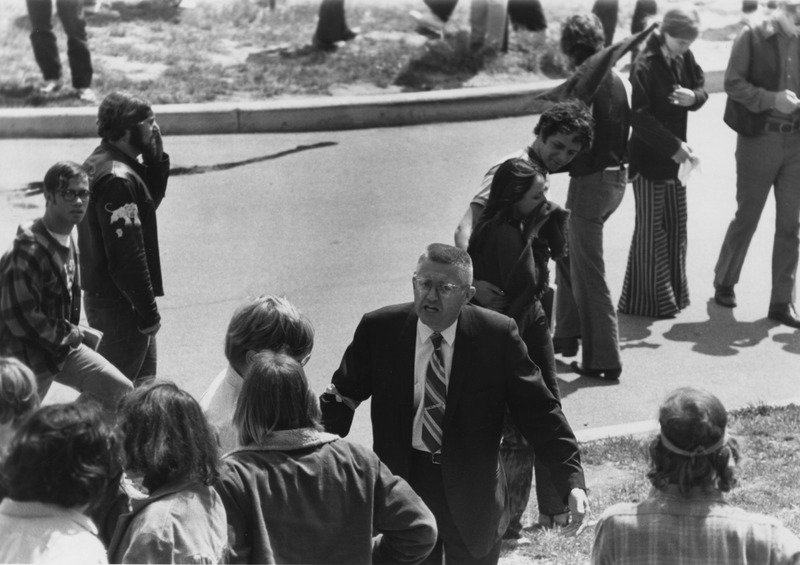
KSU faculty member Glenn Frank talking to a crowd of people, blood in parking lot is visible in background
After hearing Glenn Frank’s plea, many students left the premise and no one else was killed by the National Guard that day. However, for Glenn Frank himself, he remained deeply troubled by the events that took place. While continuing to work as a geology professor at Kent State, Glenn spent the rest of his life searching for the truth by investigating what led up to the senseless killing of four college students.
A Search for Answers
It has been 51 years since the May 4, 1970, shootings and many questions remain unanswered. The public deserves clarity. A passage of time should not comfort those in positions of power who continue to suppress the truth.
Glenn Frank’s son, Alan Frank, who was present during the May 4, 1970 shootings, shares his experience. Alan, who has been an active member of the Kent State May 4th community, revisits the work of his father who has sought answers to our many unanswered questions surrounding the events on and leading up to that day.
*
Interview with Alan Frank
The following is a transcript of an interview between independent journalist Taylor Hudak and Alan Frank, the son of Geology Professor Glenn Frank. The interview took place on May 4, 2021, at Kent State University.
A note from the author: Due to the passage of time and with many of the subjects deceased, I cannot independently verify all of the claims made during this interview. If you have additional information on the events leading up to and on May 4th 1970, please contact [email protected].
***
Taylor Hudak: First of all, Alan Frank, I want to thank you for doing this interview with me. And I know it’s been 51 years since the shooting on May 4, 1970. What does it feel like to be back here on this day?
Alan Frank: Oh, it’s something very personal to me because I just feel the need to come and pay my respects. I try to do it every May 4th when I’m in town for sure. And I’m probably going to run into some people that are very close to me that I’m looking forward to seeing.
TH: If you could just take me back to May 4th, 1970, on the Kent State campus. What was your experience?
AF: Let me go back a few days before that when Nixon announced the invasion of Cambodia. On Friday May 1st, there were a couple of rallies on campus, one where a guy buried a copy of the Constitution. That evening I was downtown. It was a beautiful, beautiful evening. People were getting kind of rowdy. And I saw a lot of people that I didn’t usually recognize. There were a lot of people that just normally didn’t come downtown like that. And there are some high school kids that were going around.
Eventually a police cruiser came through and some rocks and bottles were thrown at the police car. And eventually they put a bunch of trash out into the middle of the street on Water Street and set it on fire. And then apparently police had come in and told everybody that the bars were shut down. So part of the crowd moved up towards Main Street, broke windows and some other things.
Two friends and I eventually kicked out the bonfire that was in the street. And a lot of times you’ll see the caption there’s two or three guys by the fire and they say these are radicals that started the fire. Now, we were there kicking the fire out and hoping that the bikers didn’t beat us up.
So that evening, my father had been out of town with my my mother. And I told them that people were out, but I didn’t know if it was a riot. Everybody says it was a riot, but I didn’t experience a whole lot of that. The next day, on Saturday May 2nd, my father was contacted by Dr. Matson, who was in charge since Dr. White was off campus in Iowa at the time. He was asked to gather faculty marshals and they had a meeting at seven o’clock that evening.
At that time, for many weeks, a lot of people felt that the ROTC building was going to burn. So he was right by the ROTC building and a group of students were there throwing rocks and breaking windows. Eventually, they went to Tri Towers to get some more students to back them up. They came back and continued hurling more rocks and came down over the hill and tried to start the fire. And I just listened to a police report and it said the ROTC building is burning. And then about 48 minutes into it, it said the building looks like it’s going to go back up (in flames) again. So it took at least those 48 minutes on the tape that I had heard. There were lots of stories going around about what was going on that night (Saturday May 2nd). People saw other people with walkie talkies. A lot of them had billy clubs.
TH: These so-called radicals had walkie talkies?
AF: Right, right. Yeah. So anyhow, after a good hour to an hour and a half, they attempted to burn the ROTC building. Police were standing right by the heating plant, which was not far away from there but didn’t do anything. My dad was out there, got hit with rocks around his legs several times. My dad, Glenn Frank, was a faculty marshal. However, they were not to get into anything with any of the students and just tried to maintain order as much as possible. That was the day that he had gone out and purchased a bunch of cloth, robin’s egg blue cloth. And one of the reasons was that, and I’m sure you know this, everybody had red and blue and white bandanas. Nobody had a robin’s egg blue bandana. So he passed those out and so the faculty had those and the student marshals had white armbands. So eventually the protestors ran over to an athletic shed down near the tennis courts and set the tennis shed on fire. And apparently a tree started to burn, and they started a bucket brigade. Well, in that time, somebody had come in and finally torched the (ROTC) building. Nobody knows who.
TH: And it’s still unclear to this day?
AF: Yes, to this day. There’s 167 pages of the FBI report that are still redacted. I’ve got some pictures here, and I’ll show you. They name about 20 some people who are suspected to have participated in the burning of the ROTC building on May 2. However, almost half of them are redacted. And why on earth would they conceal the identities of the radicals who they suspected started the fire?
However, their names are redacted and when you look at their pictures, there’s black magic marker that’s just been drawn across their face so you can’t tell who it is. In some parts of the burn report, there are 25 pages at a time that are just totally deleted. You know, what’s with that?
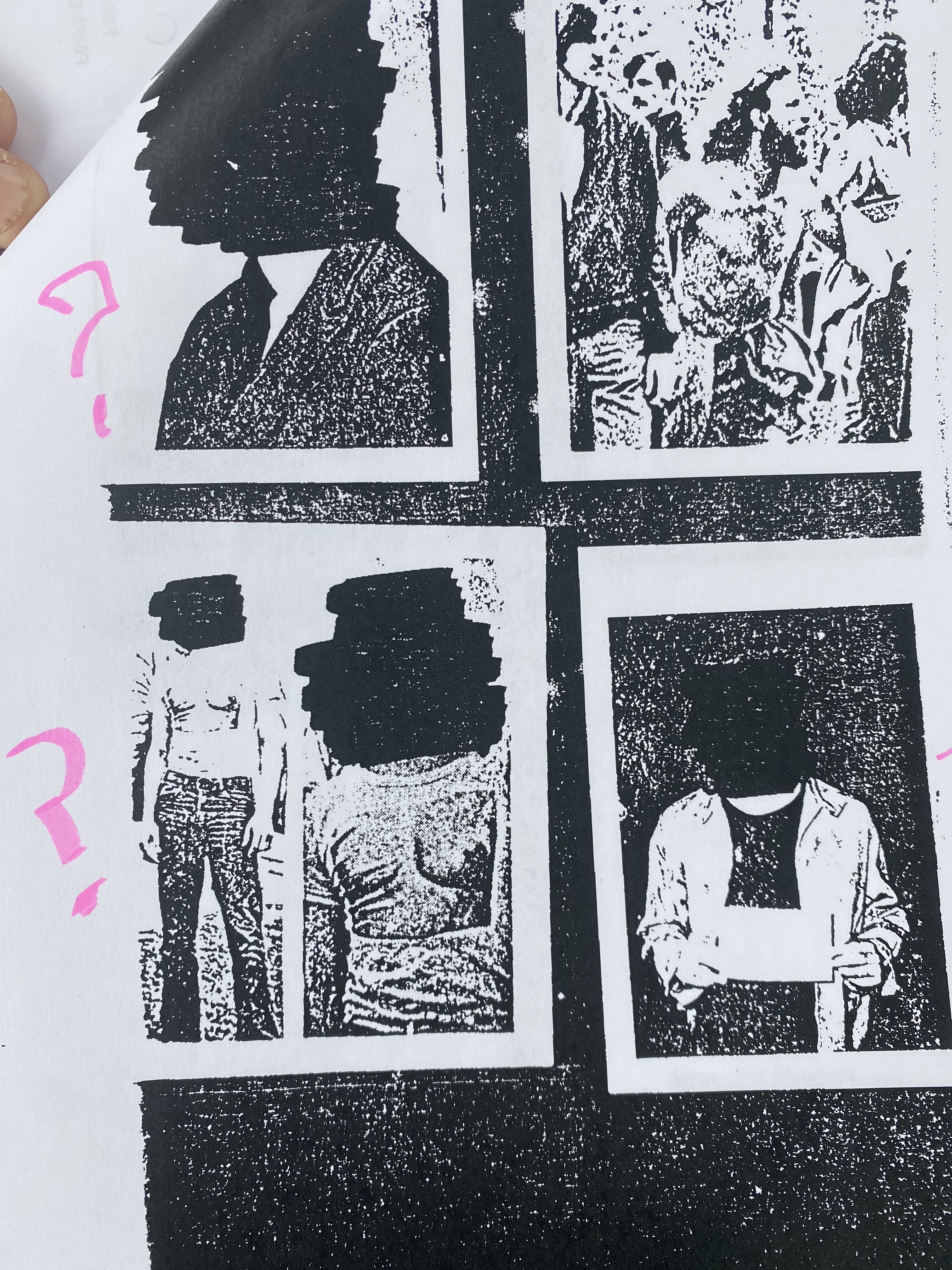

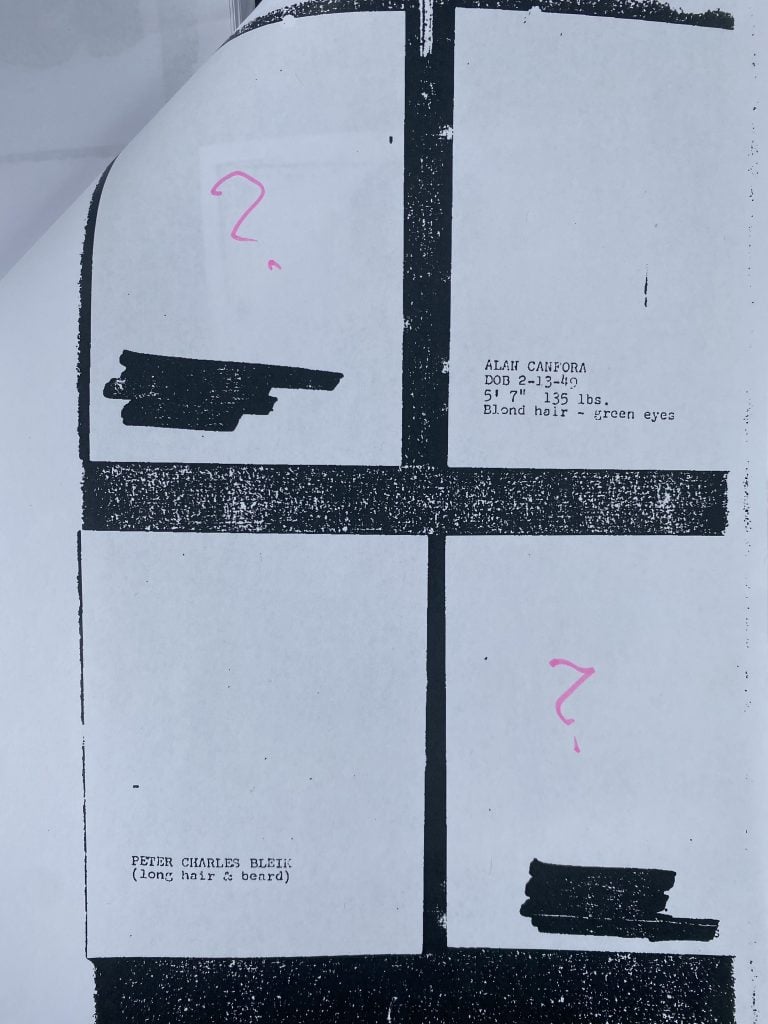
FBI report
TH: Can you think of any reason why they would do that?
AF: I’m wondering, you know, if it was a false flag operation or something like that. I’m not saying the CIA did this, but the CIA had a program called Chaos. And the FBI also had a program called COINTELPRO. So both of them had counterintelligence programs. Every military intelligence group had people that would try to infiltrate the radical groups.
So you almost wonder whether more people were infiltrating these groups than were actually the radical students a part of these groups. But there’s no doubt that some of the students tried to participate. I talked to Tom Grace and I said, Tom, I never knew that the the FBI released the burn report saying the students did it. He said, well, no, we’re pretty sure that the students did it. And I kind of called B.S. on that because there were these other people on campus that nobody recognized. Tom Grace said some had disguises on. So it’s hard to say, you know. Until the FBI releases the burn report unredacted, we’re never going to know. And I wonder, is it for national security? Is it for the fact that they’re hiding undercover agents? I don’t know. But so many different intelligence agencies were around campus at that time.
Note: Federal Bureau of Investigation (Department of Justice) Form No. 4-694a (Rev. 12-4-86), “Explanation of Exemptions, Subsections of Title 5, United States Code, Section 552”. (FOIA)
TH: Right. And there’s been a long history of infiltration in different activist groups, and it’s something that still goes on today but it’s expanded with the internet.
AF: I talked to Alan Canfora for, I don’t know, probably since this started. He was one of the people that said he and others tried to start a fire for an hour and a half, and they couldn’t do it. And then soon as he and the others left and the police surrounded the building, it went up (in flames). And I also talked to a friend of mine who is a biology professor. His name was Denny Cooke. And I said, Denny, the Justice Department has two different quotes by you. And they say, check with Denny Cooke to see which one is correct.
In one statement, Denny said that he had seen a small fire going. In the other statement, he said that it was almost out. And when I asked Denny about it at the 25th anniversary, I was right over here in the Student Center. And he said to me, Alan, you are the first person to ask me this question in 25 years. He said, I put the fire out. We talked a little bit, and he said again, I put the fire out. And a third time to make sure I got it, he said, I put the fire out. And he said, I don’t know what happened to the mob when they left. But that’s what Denny had said to me.
TH: And again, what was Denny’s position or role at the university?
AF: He was a faculty marshal and a biology professor right over here. So there are so many questions. And it just bothers me that we see things that happen in the United States, such as the January 6th attack on the Capitol building. And people aren’t trusting the police. They’re not trusting the FBI. They’re not trusting anybody and part of that, I understand because it is hard to believe the truth when you’re either not lying or you’re trying to create a situation where then you can go in and either blame it on somebody else or be the hero that solves that problem. We can’t afford to do that. I mean, it’s obvious to me that this is a great country as far as our Constitution is concerned. There are some people that are really being inappropriate with what’s happening in this country.
TH: And who would that be?
AF: Well, focusing on May 4th, what bothers me the most right now is the FBI report.
I’m just concerned. I would love to see the unredacted FBI report.
TH: And specifically on what happened on the evening of May 2? The burning of the ROTC building?
AF: Yeah, yeah. Especially, on that evening. I had another friend, who was around that evening, who sat near the victory bell watching people come out of the crowd, run up, do something and run back. And he said they did it with military precision. And I said, man, could you write that down for me? And he said no. And I’m just wondering, is that because this is a very relatively conservative guy? But for some reason, he doesn’t want to be associated with what he saw.
TH: And he saw the fire go up?
AF: He saw the fire go up.
TH: And who is this person? Do they want to remain anonymous? AF: Yes.
TH: Ok, I understand.
AF: Yeah, and he said it was like military precision when they would come up and then go back and he saw, you know, five to 10 people doing this. And many of the reports say that there were probably only five to ten people that did it. But I think they were able to talk students into being a part of it and thereby, you know, taking their role. Yeah.
TH: Yeah, that’s entrapment. I know we are speculating here, but do you think that that’s a possibility?
AF: I think so. The FBI report is very difficult to read. The copies are bad. But when you read the report, you will notice it doesn’t have the right hand margin in some of the documents and you’ve got to figure out what the words are. But this is my fifth time going through it. The first time I probably spent two hundred hours trying to figure out some of the things in the documents. In my opinion, there should be no reason to include records of the murdered students in the report. However, they talk within the first couple sections about the four students who were killed. It mentions that Bill Schroeder was a ROTC student and that he was thinking about or he was having some dissonance regarding the Vietnam War and thought about going to Canada. Now, back then, that was pretty sacrilegious, you know.
TH: Right. That was a crime at the time.
AF: Yeah.
TH: So they put this in the report to perhaps make it look as if it was acceptable to shoot the students?
AF: Exactly. That’s my feeling now. TH: And that’s in the FBI report?
AF: It’s in the FBI report. And there were two FBI reports. Well, they’re very similar. One is like one out of eight and it’s about twelve hundred pages. The other is one out of twenty two. So they’re divided up like that. But why would it even mention details about the students if you didn’t want to kind of blame them? Like Sandy Scheuer. I mean, I don’t think she was in any radical group. She was on her way to class when she was murdered. And it said, in the report, she would hang out with some of the radicals like the long hairs and the beards and stuff like that. Why would they even put that crap in there, you know?
TH: So it included information that was unnecessary?
AF: Yeah, absolutely. Absolutely. They have a story about Allison Krause going into one dorm. It says that this R.A. saw her come in and she had a bottle and she had to use the bathroom. And the R.A. said, I’m pretty sure that she went in there to pee in the bottle to spray it on people. I mean, they are making this crap up, you know?
TH: They’re smearing the victims.
AF: Exactly. Exactly. Yeah. When they are mentioned like that, when in my opinion, there’s no need to have that information in the report, I just see it as an effort to skew the narrative in a certain direction. In another 50 years, nobody’s going to know this information. They’re going to see, oh, well, you know, they all deserved to be shot. It’s garbage. It’s really garbage. So there are times when I thought either the FBI report was written in a genius manner or it was just a total screw up just because of some of the information that’s in there. So just reading through it critically and considering what they have put in there, it makes me wonder. And I don’t think it’s going to be solved until everything is unredacted.
TH: Ok. Let’s shift our focus to what took place on and around May 4th. If you can please continue to share your experience.
AF: Ok, Sunday May 3, I was not on campus. My dad was with the faculty marshals though. And at that time, I was a jock on the swim team, and a lot of jocks and frat guys were against these radicals. So I was having lunch with a friend of mine in the Student Center. After lunch, I jokingly said to him, let’s go beat up some hippies. And I ran into him a couple years ago and he said, yeah, back then we never beat up anybody, you know, we just didn’t do it. And that’s what I was joking about it.
TH: So you were more conservative?
AF: Oh, yeah, I was. I was conservative.
TH: So you were not someone who was out there protesting?
AF: I went up there on May 4th, quote, to make sure that nobody hurt the Guard. I don’t know what I would have done. I don’t know if I could have done anything, but it was such a joke. And so we walked up and stood behind the couple hundred people that were down below by the victory bell. The Guard enforced Governor’s Rhodes decision that no rallies were to be allowed. After tensions escalated, the Guard shot off tear gas. I went into Johnson Hall because I had stayed there as a swimming recruit. And so I had a connection with Johnson Hall and came out after they had gone up over the hill. And then they walked down to the practice football field.
And it was such a circus, you know, nobody was close enough to them (the National Guard). All these guardsmen say, oh, yeah, we were getting pelted by rocks. And somebody said the sky was black with rocks. It’s bullshit. And it’s the lies that are put in that FBI report that really bothered me and the BCI report, the Bureau of Criminal Investigation report. There are just so many pieces of information that are in these reports that make one think that all of these guys got what they deserved. I read in James Michener’s book, “Kent State: What Happened and why,” that a very good former baseball player went down to the site of the shooting, placed himself where one of the students was and tried to hurl a rock toward where the Guard was. And he said, you’d have to be Joe DiMaggio to be able to to hit anybody. Even the General picked up a rock and threw it back at kids. General Canterbury talked later about how he and his friend, Sylvester Del Corso, did this. General Canterbury and Del Corso said, yeah, we had a fun time this weekend throwing rocks back at these demonstrators. It’s totally, totally inappropriate and totally unprofessional. But this guy, General Canterbury, kind of bragged that he messed with the students.
And the number of people that had been bayonetted is higher than I had realized. One black guy was in a car bringing his girlfriend back to campus, and the guardsmen went through an open window and bayoneted him. And another woman got hit in the buttocks because she was trying to get into the window of the library.
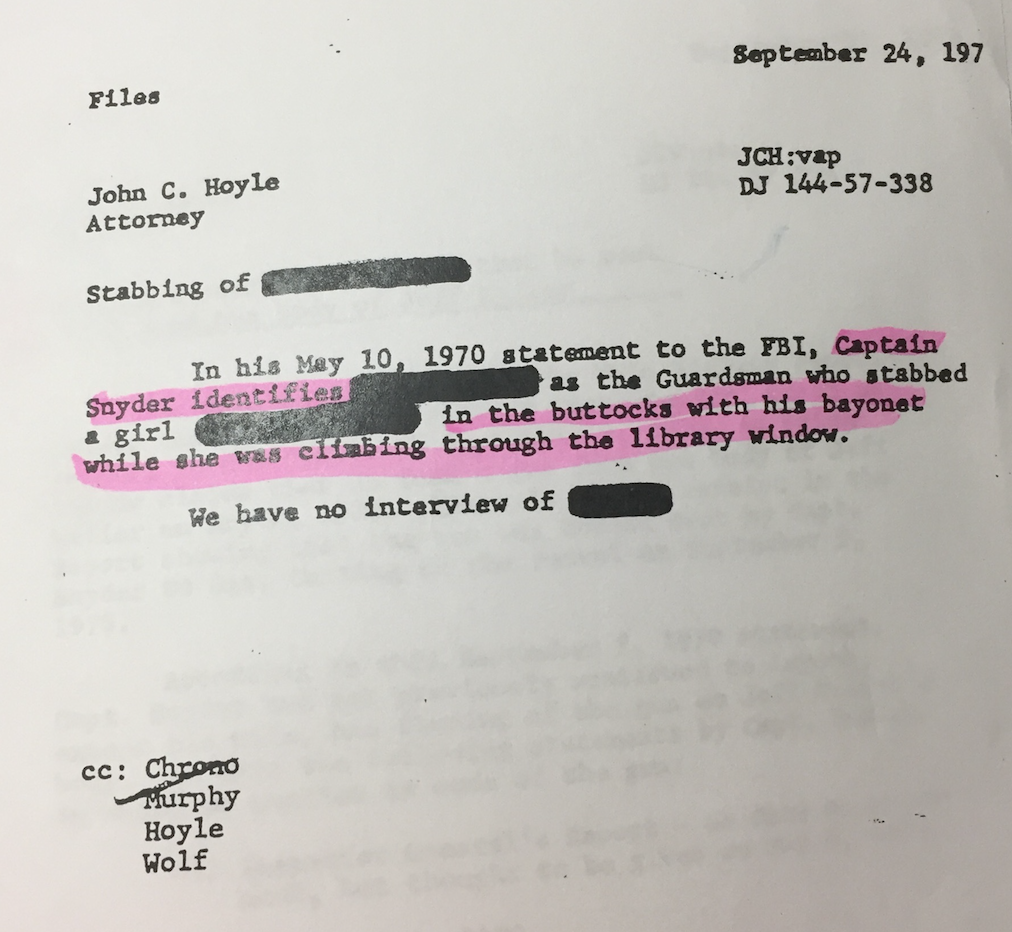
Letter from Civil Rights Divison Attorney John C. Hoyle concerning a guardsmen stabbing a girl with a bayonet. September 24, 1973.
So what the guard was doing was just totally inappropriate, which I didn’t realize at the time because it took years for this to come out. But back to Monday May 4, we get up on campus and we’re watching the circus back and forth. Now some people called it a tennis match because it was just so ridiculous. The guardsmen got down and they knelt and aimed their weapons especially towards Alan Canfora who had the black flag.
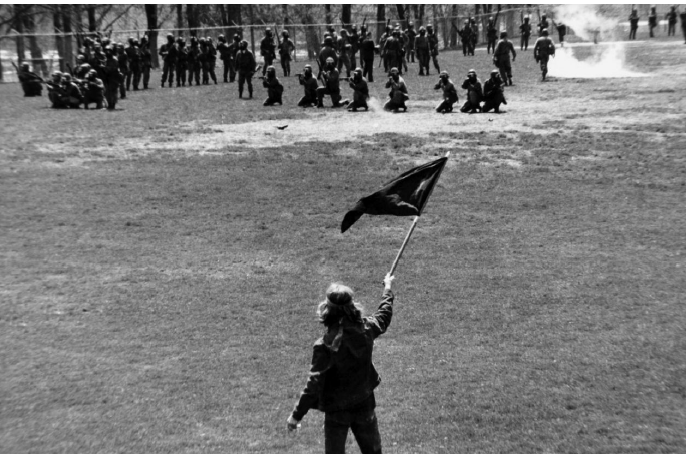
Alan Canfora waving the back flag before the National Guard on May 4, 1970. Taken by John Filo.
After about 10 minutes on the field, they started to walk back up. There’s a lot of people who were just observers on the Hill. Ten to 20 people, maybe, were throwing things. I don’t remember anybody getting hit at that time. However, as the guard is coming back up, the guardsmen report that they (the protestors) were within six inches of their bayonets and that they had to shoot in order to protect themselves. And the pictures didn’t come out initially so they had the ability to make up what was really going on.
TH: They initially said that protestors were six feet from their bayonets?
AF: Inches. Six inches from their bayonets.
TH: Well, that is definitely not corroborated by the photographic evidence.
AF: Right, exactly. So who in their right mind would even get near somebody with a bayonet? Come on. This buddy of mine from the swim team and I are walking up the hill probably 50 to 75 feet in front of the guard. We were some of the closest people there and there was no sense of danger. There were no rocks being thrown at that time that I saw, even though, people say, oh, I got hit in the stomach with a rock, I got hit in the testicles with a rock, etc.
But I felt absolutely no danger. I said to my buddy Al, shouldn’t we be walking faster? And he said, what are they going to do, shoot? And I thought, how could I be so stupid to even think that? I was embarrassed for about 15 seconds. And as we walked up, The Guard turned in unison and started firing. And we were like, whoa! And so we ran to Johnson Hall because that’s where I luckily had a connection.
Otherwise, I might have gone down near Taylor Hall where a few other people were. The photographs don’t show that at all. So we run from the top of the hill near the pagoda down into the bathroom. Meanwhile, the firing is still going on and it was like the longest 13 seconds of my life. And we’re in there (the bathroom) and we’re laughing and saying they’re shooting blanks, they’re trying to scare us, etc. The National Guard then went down the hill, and we came out the bathroom window. And I hear this guy screaming, “They killed them! They killed them!” And in my in my mind I’m thinking, what? No way. And so we came out and there’s a picture of me just kind of looking over the scene. And I walked down to where Jeffrey Miller was and Mary Ann Vecchio, the fourteen year old runaway, was by him.
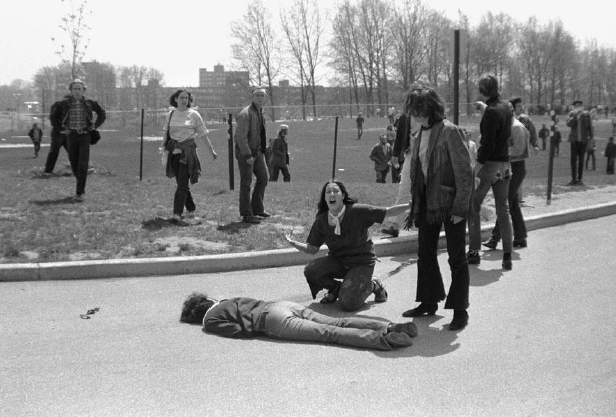
John Filo/Getty Images
So I was right there when John Filo was taking these shots. And I was in shock because I could not make a connection that there was any reason for the Guard to fire at that time. Several of the guardsmen have said that it was not a shooting situation and they didn’t feel like they were in danger. While other guardsmen said that the protestors were so close to them that they were afraid their weapons would be taken off of them by the demonstrators. Well, between Johnson Hall and Taylor Hall there was an opening pathway. They could have gone down there if they wanted to. They said a surge came up with the rocks and there was yelling. But I don’t remember any of that. I remember the shooting, and it was so totally inappropriate.
TH: Initially, when you heard the gunshots, what was going through your head at the time?
AF: We thought they were shooting blanks in an attempt to scare people. But we ran into Johnson Hall and came back out, it was like, wait a second, what is happening? This is so inappropriate and so was what came after that. One guard captain said that he had walked over to Jeffrey Miller’s body and found a pistol on him, which is totally bullshit. The Guard eventually claimed that he said he turned it into the FBI about a month and a half to two months afterwards. The FBI looked at the pistol and noticed the initials on the pistol were SNY. And the man who turned in the pistol, his name was Snyder. And it was a drop pistol. It was a pistol that was, I think, an 1850 pin fire revolver, which they don’t make ammunition for anymore. Snyder had said he was in C company between Taylor and Prentice Hall. He said that he watched Jeff Miller running back and forth with a pistol saying, “kill, kill, kill.” I mean, come on. And then people really went nuts and they found out that he (Snyder) was lying to the grand jury and everybody else. Yet nothing was ever done. Nothing was ever done.
TH: And who is this Snyder? What is his full name?
AF: Captain Ron (nickname) “Cyanide” Snyder. That’s what his nickname was to his–
TH: And what was his role?
AF: He was one of the people who was apparently making decisions on what the Guard should be doing at that time. So you know, we’re friends on Facebook. We’ve talked, and I’ve asked him certain questions. But it just bothers me that he was caught lying at least a couple of times and nothing was ever done about it.
TH: So he lied that there was a gun found on Jeffrey Miller?
AF: Yeah, absolutely. Yeah. And the FBI said, you know, the initials SNY make us doubt that–
TH: So the initials on the gun were SNY?
AF: SNY. Snyder is his name. s-n-y-d-e-r.
TH: So we can’t be sure of this right now, but it seems as if that gun was his and he placed it there?
AF: Well, it probably wasn’t even there. I believe he had it at home. You know, he had said that he turned it into the FBI a month and a half or two months later when he said they were going to charge the Guardsman with something. And so he said, well, I’ve got the perfect solution, we’ve got this gun here. And it’s just to show that these so-called radical students had weapons and therefore, the Guard was justified. But this was not true.
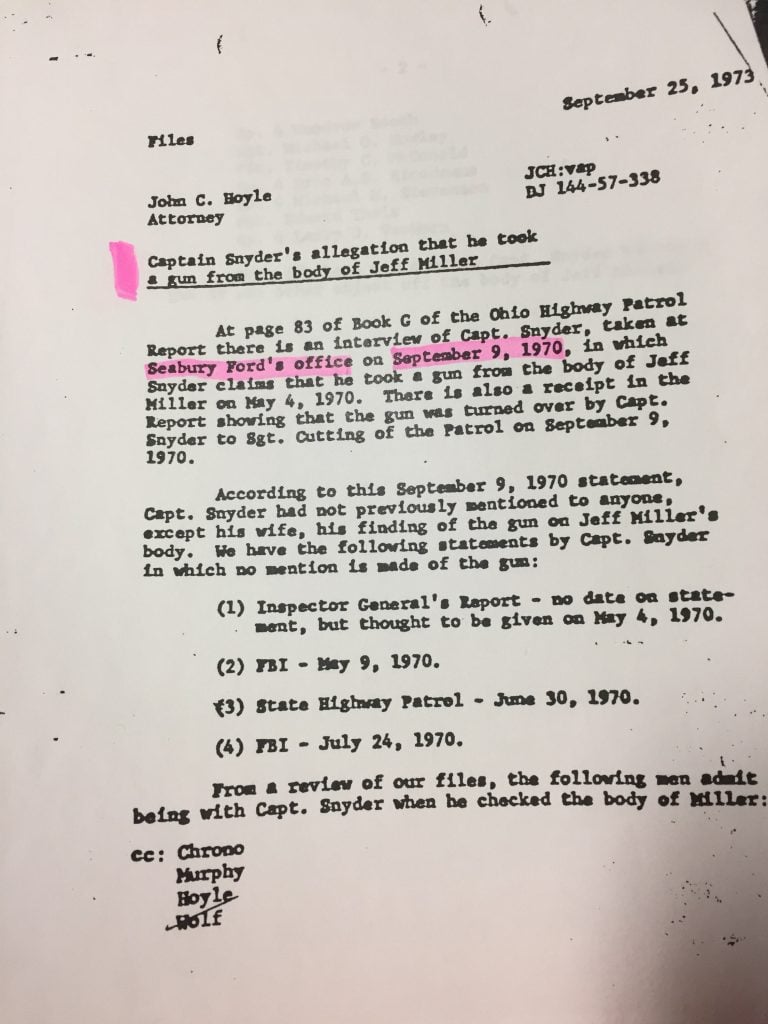
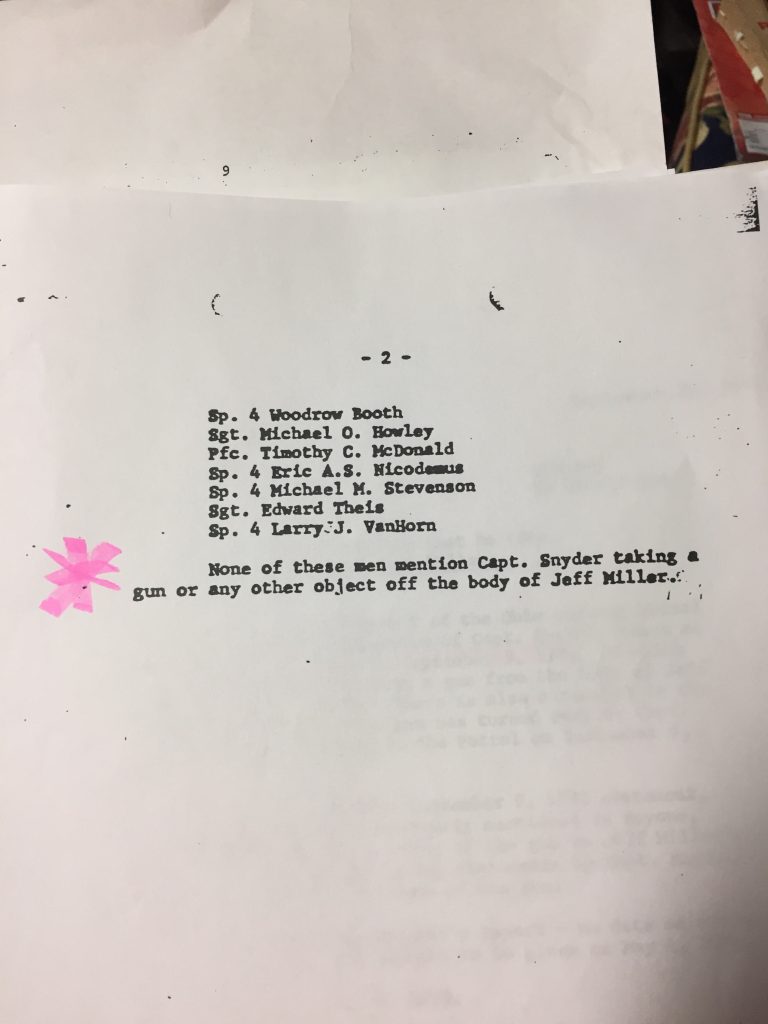
Memorandum from Attorney John C. Hoyle concerning Capt. Snyder’s allegation that he took the gun off of the body of victim Jeffrey Miller. September 25, 1973.
TH: Oh that’s beyond corrupt.
AF: Oh yeah. Yeah. There are so many stories about just inappropriate things that the Guard did, and it just bothers me. It just bothers me terribly. And the FBI report continues to allow people to believe a certain narrative. On Saturday night, May 2, when the fire truck came to put out the fire, the people that were supposedly the radicals ran up and took the fire hoses slashed them with machetes and icepicks. My dad was given a part of the FBI report that wasn’t really the FBI report, but it was all the physical evidence, at the very end it says that these items were in Seabury Ford’s office. And this brings me to another point. Seabury Ford was the prosecuting attorney who had been with 107th Cavalry and came out with a story in October saying they should have shot them all. And he said he keeps a loaded .45 in his desk, but that’s a different story. And that’s when my father said, wait a second, you know, we’re under a gag order but this guy can say whatever he wants?
(Note from the author: The investigation and gag order is addressed later in the interview)
So my dad defied the judge to arrest him. He said, I defy Judge Jones to arrest me because my dad knew if he was arrested that they would also have to arrest Seabury Ford. And like I said, that’s another story. But anyways, somebody was given a three foot piece of fire hose, a .32 caliber pistol and a machete. And you wouldn’t give these items back to radical students. So who has them? And that was redacted at the very end of the report.
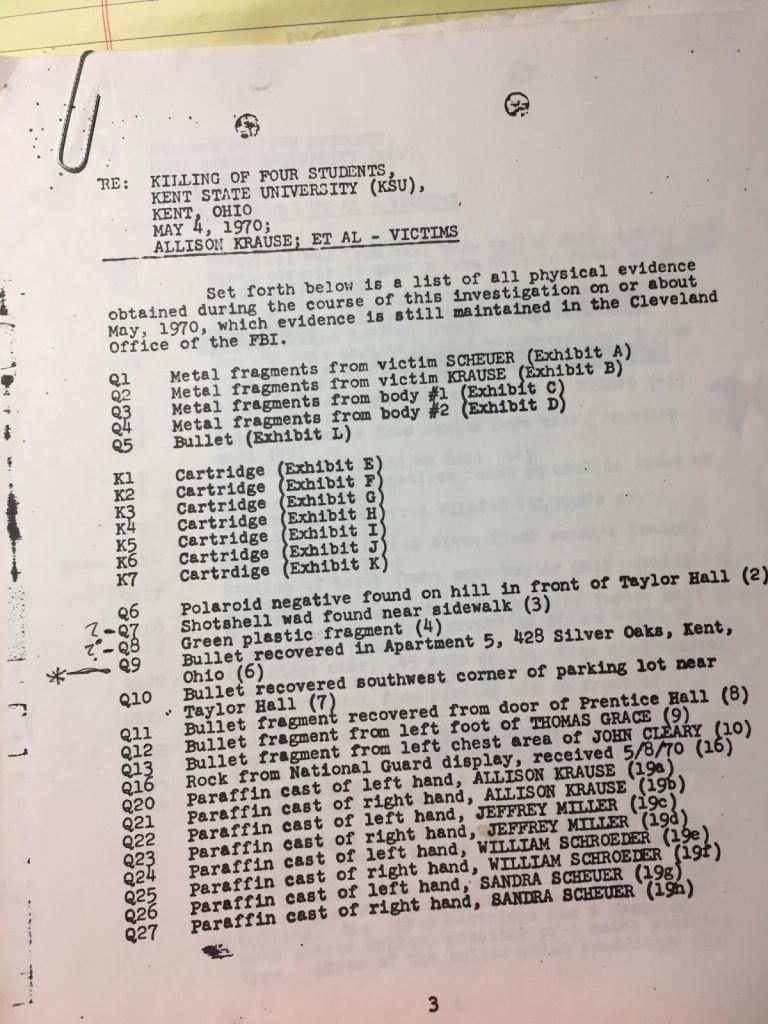
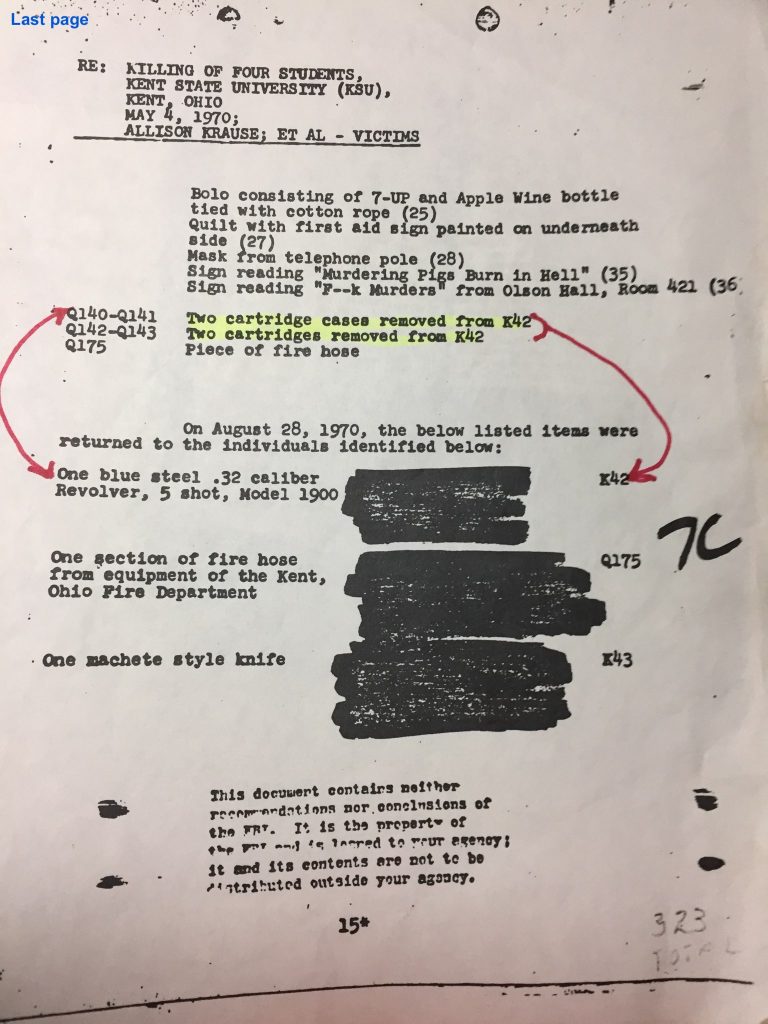
First and page of the report obtained by Glenn Frank that includes the evidence. The document shows weapons including a blue steel .32 caliber revolver, one section of a fire hose and one machete style knife was returned to individuals whose identities are redacted.
TH: So they gave these materials back to so-called radical students?
AF: Well, they gave it to somebody. I can’t say that it was radicals. Well, I’m sure it wasn’t radical students, because if there was any way to indicate that they deserved what they got by being in possession of these items, they would have made it public. But I think somebody in charge got these things as mementos. One thing Ron Snyder said to me was, I’m probably the only person that has a weapon that was up on campus that day. And I didn’t respond to that statement. But, yeah, he had brought several illegal weapons. He brought a .22 Beretta that he gave to Major Jones. In Michener’s book, Snyder was talking about Jeff Miller running back and forth and he said, I had just about decided to shoot him with my revolver. And my dad goes, wait a second, would a captain in the guard refer to their sidearm .45 as a revolver unless he had another illegal weapon? And so then Snyder and some of his guys walked over to Jeff Miller’s body.
Somebody tried to “toe” him over the Guard (use boot to toe him over) and people went nuts. I mean there was blood just flowing down the asphalt. According to Michener, Snyder had gone over to there to make sure he was dead. Now, my dad said if you weren’t part of the shooting, wouldn’t you go over there to make sure he was alive?
TH: That is a great question. It doesn’t add up. But I wanted to ask you about your dad, Glenn Frank. And his role in all of this? Because he had a significant role on May 4, 1970, and is credited with saving many, many lives.
AF: Absolutely. Absolutely. On that day, my dad came out of the Student Center and got in an ambulance. When he jumped into the ambulance, he just said, that’s it, take me up there. And it shows them going up near Taylor Hall in this ambulance. And at the time, I was wandering around in a daze, I’m sure. And once he got there, I walked up to him and he pointed his finger at me and he goes, “you get the hell out of here.”
TH: Your dad said this to you?
AF: My dad. Yeah.
TH: How did you feel at the moment?
AF: I knew I wasn’t going to get out of there because what I had just seen was murder. You know, there’s just absolutely no way.
TH: Were you there when your dad told the students to leave and that this wouldn’t end well?
AF: Yes. Yeah.
TH: Tell me about that moment.
AF: There were probably 1,000 students who were there including jocks and fraternity guys and other people who had showed up just because of what had happened. And so I sat down and many, many other people sat down. And my dad and I never talked about this, but I’ve always wondered what would I do if I thought my son might be in a situation where within five minutes he could be in a shooting situation. And just one bullet into a crowd would probably go through at least six, seven, eight people. So it would have been a slaughter. And my dad even mentioned that in his speech. But I was not going to move. I remember him coming back and forth between The Guard and the students and some of the other faculty.
And I thought, this guy is going to try to get me to move and I’m not moving. I made my decision. I just saw murders take place. And this was the only thing I felt that I could do to protest. But when he said what he said and then he ended with “Jesus Christ, I don’t want to be a part of this,” it was shocking. It was such an incredible moment. Jerry Lewis, a sociology professor, said it was like a prayer, an anguished plea. And people heard my dad’s words and we all just started to stand up and walk away.
And I saw Dad and he had his head down and he was kneeling on the ground. He was crying. And I thought somebody had hit him in the head with a rock. That’s all I could think of. And a friend and I walked him over to the tennis courts just to get away from The Guard. But yes, he saved hundreds of lives that day. No question. And I was one of them, you know, because I was not going to listen to him. I was not going to move.
TH: Your dad had dedicated so much of his life to investigating exactly what had happened on that day. Can you talk about why your dad was so passionate about getting to the truth?
AF: One of the things that my dad said was that he was so high on America. And he would do whatever it took to find it out what really happened. He was in the Marines, he was a scout leader and he was a Boy Scout. He was pretty conservative, which is where I’m sure I got my views from at the time. And the more that he looked into it (what happened on and around May 4, 1970, the more he said, “my country doesn’t do this, my country doesn’t do this.” I’m sure he felt that the country was constitutionally wonderful, and he just he could not believe that this happened.
TH: Do you think it changed his faith in the system and in the intelligence community?
AF: Yeah, yeah. He was able to contact people in the CIA. He got access to the quote secret police files. He had friends all over and they were pretty much conservative, law abiding people. He was in the Fraternal Order of the police. He had the ability to talk to anybody about anything and was able to add a different perspective. And he said, I’ve always felt that I need to know my perspective and I need to know the other perspective as well so I can to be able to to discuss a situation. But I don’t know if he ever had good access to the FBI report. But I came across a couple files within the last month or so that were just sitting up in my attic. And he had so many files on so many people. I mean, if he talked to somebody about Kent State, he would make a file. With regard to the gag order from October, when the prosecuting attorney said they should have shot all students, somebody started a petition drive to support my dad. And there were like 5-6,000 signatures in this one file. So there was so much support for him. But he was finally arrested, I think on the last day of probably spring quarter. And he announced it to his class that if somebody comes in everything’s fine.
TH: And what exactly was he arrested for?
AF: He was arrested for breaking the gag rule.
Note:
In the fall of 1970, A Ravenna Grand Jury assembled to investigate the Kent State shootings. The court implemented a gag order, which prevented anyone involved in the investigation from speaking on the case. Seabury Ford, a special prosecutor overseeing the case, violated the gag order by speaking to the press, where he is quoted in an article saying, “National Guardsmen should have shot all the trouble-makers.” After seeing such a comment by one of the prosecutors, Glenn Frank spoke out in response, and both Frank and Ford were charged with contempt of court. However, following Frank’s arrest, he received a significant amount of support from his students. You can view news coverage of the incident and the letters of support here.
TH: Ok, let’s talk about the aftermath here and the investigation. Your dad was he skeptical of the official narrative, right?
AF: Eventually, he was. I think initially he felt ok this is what it appears to be. He talked to certain professors that had maybe more of a radical viewpoint, and they gave him enough information that he started to question the official findings. And eventually he testified in front of the Scranton Commission. And the Scranton Commission essentially said that they felt that the guardsman had fabricated their side of the story. He felt that they got together and said that no this isn’t what happened. And the more information he was able to obtain, the more he questioned some of the things that people, not the government necessarily, but people were claiming. So it was just such a painful event. He and I never ever really talked about it.
TH: You never really talked about it?
AF: No. Oh, no, no. I mean, I remember one time one of the police officers had mentioned to him that he was on a hit list–
Caption: First and page of the report obtained by Glenn Frank that includes the evidence. The document shows weapons including a blue steel .32 caliber revolver, one section of a fire hose and one machete style knife was returned to individuals whose identities are redacted.
TH: So they gave these materials back to so-called radical students?
AF: Well, they gave it to somebody. I can’t say that it was radicals. Well, I’m sure it wasn’t radical students, because if there was any way to indicate that they deserved what they got by being in possession of these items, they would have made it public. But I think somebody in charge got these things as mementos. One thing Ron Snyder said to me was, I’m probably the only person that has a weapon that was up on campus that day. And I didn’t respond to that statement. But, yeah, he had brought several illegal weapons. He brought a .22 Beretta that he gave to Major Jones. In Michener’s book, Snyder was talking about Jeff Miller running back and forth and he said, I had just about decided to shoot him with my revolver. And my dad goes, wait a second, would a captain in the guard refer to their sidearm .45 as a revolver unless he had another illegal weapon? And so then Snyder and some of his guys walked over to Jeff Miller’s body.
Somebody tried to “toe” him over the Guard (use boot to toe him over) and people went nuts. I mean there was blood just flowing down the asphalt. According to Michener, Snyder had gone over to there to make sure he was dead. Now, my dad said if you weren’t part of the shooting, wouldn’t you go over there to make sure he was alive?
TH: That is a great question. It doesn’t add up. But I wanted to ask you about your dad, Glenn Frank. And his role in all of this? Because he had a significant role on May 4, 1970, and is credited with saving many, many lives.
AF: Absolutely. Absolutely. On that day, my dad came out of the Student Center and got in an ambulance. When he jumped into the ambulance, he just said, that’s it, take me up there. And it shows them going up near Taylor Hall in this ambulance. And at the time, I was wandering around in a daze, I’m sure. And once he got there, I walked up to him and he pointed his finger at me and he goes, “you get the hell out of here.”
TH: Your dad said this to you?
AF: My dad. Yeah.
TH: How did you feel at the moment?
AF: I knew I wasn’t going to get out of there because what I had just seen was murder. You know, there’s just absolutely no way.
TH: Were you there when your dad told the students to leave and that this wouldn’t end well?
AF: Yes. Yeah.
TH: Tell me about that moment.
AF: There were probably 1,000 students who were there including jocks and fraternity guys and other people who had showed up just because of what had happened. And so I sat down and many, many other people sat down. And my dad and I never talked about this, but I’ve always wondered what would I do if I thought my son might be in a situation where within five minutes he could be in a shooting situation. And just one bullet into a crowd would probably go through at least six, seven, eight people. So it would have been a slaughter. And my dad even mentioned that in his speech. But I was not going to move. I remember him coming back and forth between The Guard and the students and some of the other faculty. And I thought, this guy is going to try to get me to move and I’m not moving. I made my decision. I just saw murders take place. And this was the only thing I felt that I could do to protest. But when he said what he said and then he ended with “Jesus Christ, I don’t want to be a part of this,” it was shocking. It was such an incredible moment. Jerry Lewis, a sociology professor, said it was like a prayer, an anguished plea. And people heard my dad’s words and we all just started to stand up and walk away. And I saw Dad and he had his head down and he was kneeling on the ground. He was crying. And I thought somebody had hit him in the head with a rock. That’s all I could think of. And a friend and I walked him over to the tennis courts just to get away from The Guard. But yes, he saved hundreds of lives that day. No question. And I was one of them, you know, because I was not going to listen to him. I was not going to move.
TH: Your dad had dedicated so much of his life to investigating exactly what had happened on that day. Can you talk about why your dad was so passionate about getting to the truth?
AF: One of the things that my dad said was that he was so high on America. And he would do whatever it took to find it out what really happened. He was in the Marines, he was a scout leader and he was a Boy Scout. He was pretty conservative, which is where I’m sure I got my views from at the time. And the more that he looked into it (what happened on and around May 4, 1970, the more he said, “my country doesn’t do this, my country doesn’t do this.” I’m sure he felt that the country was constitutionally wonderful, and he just he could not believe that this happened.
TH: Do you think it changed his faith in the system and in the intelligence community?
AF: Yeah, yeah. He was able to contact people in the CIA. He got access to the quote secret police files. He had friends all over and they were pretty much conservative, law abiding people. He was in the Fraternal Order of the police. He had the ability to talk to anybody about anything and was able to add a different perspective. And he said, I’ve always felt that I need to know my perspective and I need to know the other perspective as well so I can to be able to to discuss a situation. But I don’t know if he ever had good access to the FBI report. But I came across a couple files within the last month or so that were just sitting up in my attic. And he had so many files on so many people. I mean, if he talked to somebody about Kent State, he would make a file. With regard to the gag order from October, when the prosecuting attorney said they should have shot all students, somebody started a petition drive to support my dad. And there were like 5-6,000 signatures in this one file. So there was so much support for him. But he was finally arrested, I think on the last day of probably spring quarter. And he announced it to his class that if somebody comes in everything’s fine.
TH: And what exactly was he arrested for?
AF: He was arrested for breaking the gag rule.
Note:
In the fall of 1970, A Ravenna Grand Jury assembled to investigate the Kent State shootings. The court implemented a gag order, which prevented anyone involved in the investigation from speaking on the case. Seabury Ford, a special prosecutor overseeing the case, violated the gag order by speaking to the press, where he is quoted in an article saying, “National Guardsmen should have shot all the trouble-makers.” After seeing such a comment by one of the prosecutors, Glenn Frank spoke out in response, and both Frank and Ford were charged with contempt of court. However, following Frank’s arrest, he received a significant amount of support from his students. You can view news coverage of the incident and the letters of support here.
TH: Ok, let’s talk about the aftermath here and the investigation. Your dad was he skeptical of the official narrative, right?
AF: Eventually, he was. I think initially he felt ok this is what it appears to be. He talked to certain professors that had maybe more of a radical viewpoint, and they gave him enough information that he started to question the official findings. And eventually he testified in front of the Scranton Commission. And the Scranton Commission essentially said that they felt that the guardsman had fabricated their side of the story. He felt that they got together and said that no this isn’t what happened. And the more information he was able to obtain, the more he questioned some of the things that people, not the government necessarily, but people were claiming. So it was just such a painful event. He and I never ever really talked about it.
TH: You never really talked about it?
AF: No. Oh, no, no. I mean, I remember one time one of the police officers had mentioned to him that he was on a hit list–
TH: Wait. What kind of hit list?
(See attached photo evidence for more details)
AF: A hit list, an assassination list. He was told by a person that he was on two assassination lists. President White was on two or three and he said he was only on one. And it was almost like this person was sharing this information with my dad and my dad’s thinking, why the hell would I be on any of them? You know? So anyhow, finally, my dad said to the guy, are you CIA? And the guy just kind of stopped. And he said, well, no, but we’ve had a long relationship.
TH: Well what does that mean?
AF: Exactly. Exactly!
TH: This man told your dad that he was was on an assassination list?
AF: Yes and so did one of the police chiefs as well as one of the people with the Mod Squad.
TH: And who is this person? Do you know?
AF: His name is Barclay McMillen. (McMillen was a professor at Kent State at the time) And he wrote some things about what was happening. I don’t know what his official position really was. But the CIA had another program way back when where they were recruiting or getting people from the CIA to be involved in university positions.
TH: So there was a CIA program to infiltrate the universities?
AF: Yeah, yeah. So it was not just the radical student organizations which they tried to infiltrate create problems when there were no problems. I shared this with Alan Canfora before he died and that this guy was a DEA agent.
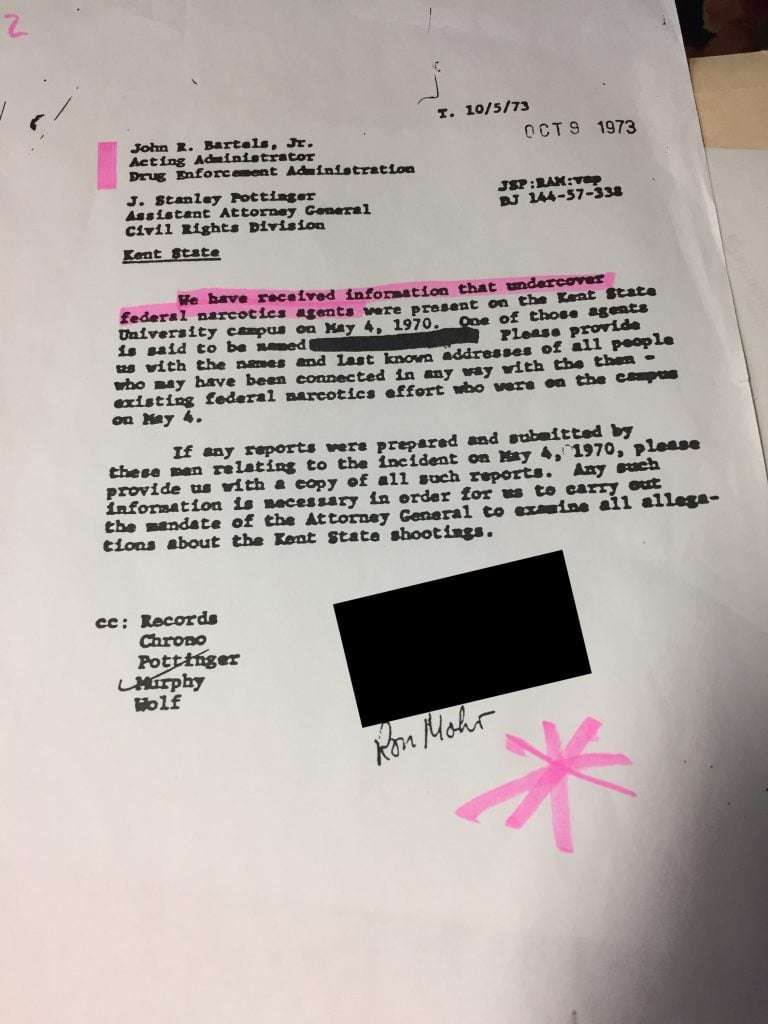
Memorandum from Acting Administrator of the DEA John R. Bartels, Jr. to J. Stanely Pottinger the Assistant Attorney General for the Civil Rights Division requesting information on DEA agents who were present on the Kent State campus on May 4, 1970. Ron Mohr is written on the document. October 9, 1973.
And you don’t know if these people are CIA or exactly what because the CIA has had the ability to put people in certain positions where you didn’t know that they were really CIA. I mean, I’ve heard that once a spook, always a spook. And so with this particular guy, in 1972, he went to the Vietnam vets–
TH: What is his name? Who is he?
AF: His name is Ron Reinhold Mohr. And Reinhold Mohr told people at the VVAW, Vietnam Vets Against the War, that they should kill some pigs. And they said, really? He said he had an automatic AK-47 and a grenade launcher. And they said, oh, gosh, you know, why don’t you bring them over so we can take a look at them? In the meantime, they contacted the Kent Police, the city police, and they said we got this nut case that’s saying that we should kill pigs. And one of the people that he had talked about was a guy named Willie. Willie was a big, heavyset black guy who is the most wonderful person. I mean, if anybody ever hurt him, whether it was radicals or whatever, they would have been wiped out. The students would be angry because Willie was just a wonderful person.
So he (Mohr) suggested that Willie should have been killed. And so anyhow, they contacted the Kent City Police and they (VVAW) arranged for this guy to come over and show them the weapons. There was the AK-47, you know, an automatic weapon. And many times you’ve got a gas port and there was a little tiny hole drilled into the gas port. So on this weapon you had to continue to pull the trigger. You couldn’t just pull the trigger and then shoot automatically. And so what happened was the police came in, they busted the guy and took him down to the police station. And they get a call from the Kent State University police saying you just busted our number one undercover agent.
TH: Is there any proof of documentation of this?
(See attached documents)
AF: I’ve got reports from a guy by the name of Mike White who writes about it. Another guy by the name of Alan Morris who was with the VVAW at that time. So a lot of people have talked about this. Then they eventually let him go since it was an automatic weapon and a grenade launcher despite that it was illegal.
I think they were made illegal in the 68′ if I’m not correct. But anyhow the ATF had to be called in, the Alcohol, Tobacco and Firearms because this is illegal. And so they came in and they examined the weapons and they said, well, the AK-47 had a little hole drilled into the gas chamber and the VVAW said it would take one little tiny spot weld and it would be fully automatic because it’s the guts inside that make it an automatic, either semiautomatic or automatic.
So they said that it wasn’t really automatic and they said there were no gas containers for the grenade launcher or no grenades with the grenade launcher. You know, this is bullshit. Anyhow, Reinhold Mohr eventually got sacked at the university, sued later, got his position back, plus all of his back pay. He sued the university to get his job back in his back pay and eventually was successful in doing that.
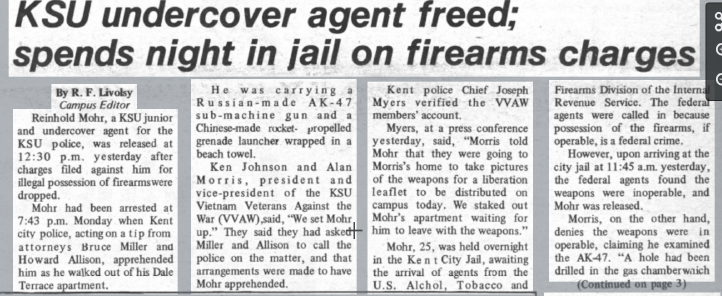
Article from The Daily Kent Stater, April 26, 1972
TH: Really?
AF: Yeah. So, you know, the people that are pulling the strings will do it for what they feel is appropriate. But Reinhold Mohr, I saw his name on something that said he was a DEA agent. There were three DEA agents on campus at that time. And there was also a document that my dad got from the police. It was a list called the Mod Squad. And there are 32 people, students, whatever, or police that were on the Mod Squad. They were undercover. And Reinhold Mohr was one of the people, an agent provocateur, getting this stuff out there.
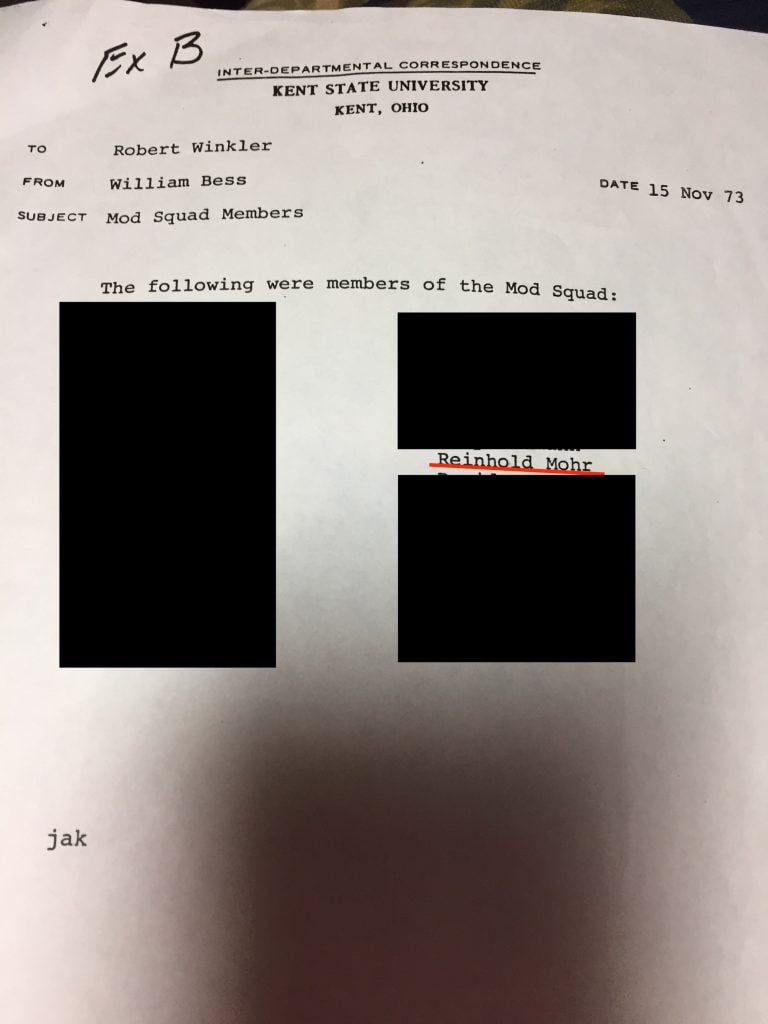
William Bess, with the Kent State University police, correspondence to KSU President Robert Winkler with a list of the Mod Squad members. The list includes Reinhold Mohr. November 15, 1973.
I’m reminded of my dad trying to talk to Bob White about this. Bob White was the president of the university and he and Bob had a great relationship. A little side story– many years before, Bob White had announced to the faculty that tuition was not going to go up a certain quarter. So my dad got into the class and announced to the students that tuition is not going to go up next quarter. Well, then all of a sudden, Bob White said tuition is going to go up. And my dad was furious and he called up Bob. And Bob said, Glenn, now I want you to just wait for a moment. Wait five minutes, and if you still feel the same way, call me back. So my dad watched the clock to the second to call him back and told him what he thought. And as a result, tuition didn’t go up that year. I mean, there weren’t that many professors on campus at that time and a lot of people knew everybody else. But he wanted Bob to tell him what happened on May 4th. He would ask Bob and say, just tell me.
And Bob said, I cannot. And this was many years later. This is probably close to 20 years later. Bob gave my dad a letter saying I cannot comment on something that’s still actionable. So somebody is telling him, you say this and you’re going to get in trouble. And eventually Bob sent him a little letter saying, Glenn, you’re a good guy, a good man, and I’m sorry that you’re so– I can’t remember the exact word that he (Bob) used. But essentially, it said, I want to tell you that from my better than average point of view, there were crazies on all sides. And he said that’s more than two or three. I can’t remember exactly what was in the letter.
But I think he died with information that we need to know about. And from Bob, we will never, never hear it. So I think it’s going to take either people that were actively involved in this stuff to come forward. I think that the people that were redacted in the FBI report should come forward, but most of them are probably dead. And many people had never seen so many of these quote radicals before on campus.
TH: It’s quite telling the FBI would redact the names and black out the faces of some so-called radicals but not others. I mean that cannot be common practice?
AF: Yeah. It’s crazy. Isn’t that crazy?
TH: It is. I mean, I can’t verify this but it seems a likely explanation is that these people were cops or informants working for the police. But I want to shift the focus back to your dad and the work he was involved with after the shootings. What was it like to see him research and dedicate so much of his time to determining what happened on May 4th, 1970? And also, did his perspective on the United States change after all of this?
AF: I saw what it was doing to him. I saw that he was just so focused on getting whatever information that he could. And I would ask my dad why he was doing this. But I didn’t have the knowledge that he had. Had I had this knowledge, I would have been going, wow, are you kidding me? You know, this is incredible. So hopefully he had access to certain parts of the FBI report. I really don’t know. He died in 93′ so 23 years afterwards. But he didn’t care where the truth took him, he just wanted the truth to come out. He talked to governors and he talked to anyone who could give him information.
TH: Did the official reports or initial media coverage of the May 4th shootings coincide with what you experienced on that day?
AF: No, no. Well, to say that the Guard felt that they had to fire to extricate themselves doesn’t match with my experience. No way. I was one of the closest people to them. I would guess 50 to 75 feet away because we were walking just in front of them. But Joe Lewis, a protestor, was giving them the finger. Larry Shafer is the only guardsmen who admitted to shooting someone, and he shot Joe Lewis. And he said that this guy (Lewis) was approaching him. He (Shafer) said he couldn’t see what was in his left hand and in his right hand he was giving him the bird. Reports are that he was anywhere between 60 and 71 feet away when Shafer fired. Apparently, he shot him twice, once in the leg and once in the groin. And the story that I had heard was that he (Shafer) bragged about it. And a couple of people fired their shotguns. James Russell was hit by a shotgun around 350 feet away. Another friend of mine said that he was up on the railing at Taylor Hall, and there are a lot of people at Taylor Hall, but they fired down into the parking lot. The closest person was Jeffrey Miller who was 270 feet away. Sandy and Bill were, I think, 390 feet away when they were killed. And Allison was 330 feet away. So there’s absolutely no way that these people were a danger to anybody.
TH: Exactly.
AF: It’s almost like people who are being bullied, and they finally have a chance to get back at the bully. I just feel that many of the guardsmen felt, fuck you, you know, we’re going to show you.
TH: I can see that. So taking a step back a little bit and looking at the broader picture, what does it tell you about the United States’ military industrial complex? I mean, these were students who were protesting the Vietnam War, and they have a right to do that. And meanwhile, the intelligence community is, and still to this day, putting a lot of funding, time, money and energy into these different programs to infiltrate these activist groups. What does it tell you about the importance of the United States’ war efforts?
AF: There’s a person that I contacted within the last year or two, his name is Christopher Pyle. He was either a major or a captain in charge of army intelligence. And they had over a thousand agents that would infiltrate these different groups.
TH: At what time was this?
AF: He finally came out with this in April of 1970, and said we got to stop this. So just just before the shootings. It’s Christopher Pyle. He’s a professor at Mount Holyoke. I contacted him about the possibility that it could have been Army intelligence that burned the ROTC building. He didn’t think so because essentially that would be a good skill to have. Even though around the United States, several ROTC buildings were burned and one was in Tuscaloosa, AL, and that guy was an FBI agent. Some people say there were no provocateurs. Sorry. Every military agency has provocateurs infiltrate groups except possibly the Coast Guard. I don’t know. I’ve never seen anything with the Coast Guard. But Army, Air-Force, Marines and Navy all had these programs. And the purpose was to infiltrate these groups. And how many of those people are the ones who might try to turn up the heat just a little bit like Reinhold Mohr? How many people before that? There are so many stories about Central Intelligence having agents who were following Mark Rudd from, I think, Mark is at Colombia?
TH: And he was with Weather Underground at the time.
AF: Yes. You know, my buddy who said he had seen these five or 10 people on Saturday night burn down the ROTC building, he purposely stayed away on Monday because he didn’t trust what could happen. And he was right.
TH: Now, I want to shift focus back on your dad and the work that he’s done.What was his perspective on, say, the United States after this had happened as well as the military and the intelligence agencies?
AF: You know, deep down, I believe he just felt that we still have the greatest country in the world, but the things that certain people were doing was just totally inappropriate.
TH: It’s been 51 years since the shootings, how has this impacted the Kent State community and what has the community done to commemorate the lives lost?
AF: I’m fairly certain that the community wanted to let it go. I mean, even weeks later, people were saying, oh, come on, this is old news. I never knew that the quote radicals on campus were were bad enough that they would go up to the store owners and threaten them with burning their shops if they didn’t put either peace signs or “get out of Vietnam” signs on their windows. So my dad was like, ok, yeah, I understand where they were coming from. But essentially they’re believing the big lie, you know, and it’s a big lie. And it’s just so unfortunate. And for me, in this day and age, I think it’s going to be so important to recognize the mistakes that we’ve made and decide that we can’t continue to do this or else we’re going to get more people breaking into The Capitol, etc. We can’t afford to continue the way we’re going.
TH: Can you be a little more specific?
AF: We can’t continue to have people create problems and then have those same people solve the problems that they created. So it bothers me. And I still believe this is one of the greatest countries, but we have screwed so many things up. It’s the individuals. It’s the individuals that think that they’re above the law and who are doing things that are just totally inappropriate.
TH: You have been very involved in the Kent State May 4th community and keeping the memory going. How has that process been over the past 50 years?
AF: Well, relating back to the town and gown relationships, it used to be terrible. It was terrible. And I see people that are trying to pull everyone together. I’ve also seen the people that still believe that they should have shot more students or all students on that day. But they may not know some of the things that actually happened to get us to that point. As I said, why would you even have something in an FBI report about people who were murdered that demonizes them? You’re going after the victim again. And I just want to be able to trust what people say initially. Maybe it’s my naiveté, but initially I want to believe what people are doing until I find out, wait a minute, yeah, that’s not true. But that’s not even close.
TH: What has it been like organizing events with others who were also present on that day? Is there a group of people from your generation who are keeping this going?
AF: Yeah, myself and three or four other people were trying to give support to the May 4th Task Force. And I used to tell Alan (Canfora) all the time, thank you for doing what you do because I wasn’t physically capable of doing it. I continue to have chronic pain. And there are times that I can’t do it, but there are times I can’t not do it. It’s too important. And I even talked to Seymour Hersh. He said to me, why are you looking into this? There were so many other things that were going on. Hersh also told me that Kent State offered him a lot of money to come and speak at the 50th anniversary. And I said, well, just come to my house and stay, you’ll have a much better time just hanging out than you will with the university people. He sees so many things and he has information about so many activities that he just felt it was just ill-trained guards.
TH: Sy Hersh? Really?
AF: Yeah.
TH: When was this? When did you last speak with him?
AF: Oh, within I say, I was trying to think if it was before Covid. It was within the past few years or so.
TH: We, of course, today still have many protests in the United States. But what are your thoughts on how protests and organizing today has changed compared to back in 1970.
AF: I think one of the most important things is that everybody walks around with a camera, essentially. And they can film the actual things that are occurring, such as the George Floyd killing. Had we believed what was in the initial report that George Floyd had a medical emergency is nothing compared to the filming of the actual event. And yet we had a lot of people that were photographers taking pictures that day (May 4th 1970). A lot of the things that haven’t come out, as far as I’m aware, you know, there just thousands of pictures from that day.
I’m not sure about anybody else, but for me, I’m always aware that I never want to say something that I wouldn’t want the entire world to know about me. And with Derek Chauvin, I don’t know that he could have possibly thought the inappropriateness of his restraint with George Floyd would not be public. How was it that he didn’t think somebody’s going to come back and show this unless he just felt that, you know, police had immunity?
TH: So lastly, is there anything else you want to add? Anything else you would like to say about your dad and his legacy?
AF: Yeah. My dad would be the last person to ever think that he was a hero that day. But he was. He absolutely was. And some people have seen the 1981 docudrama of him, and the person who portrayed him is nothing at all like him. This guy was a homer milquetoast. And my dad would do whatever he needed to do. Like when we all sat down in front of the Guard and he basically said “if you’re going to shoot somebody, shoot me.” He ran up as Major Jones was coming down the hill with a whole line of guardsmen. And unfortunately, a friend that helped with this video that’s on the website absconded with this film. And in 25 years, I finally found out that he’s around this area. But essentially it shows my dad running up to Major Jones. And Major Jones said, I have my orders and my dad said over my dead body. And that’s when Jones threw his baton down and they stopped. And my dad meant it what he said. He absolutely meant it– if you’re going to kill somebody, kill me.
TH: Very heroic.
AF: Yeah.
TH: Alan Frank, thank you for your time and for sharing your story with me today.
**
The events of May 4, 1970, have left a generation with considerable pain, frustration and a yearning for answers. Professor Glenn Frank’s heroic actions saved hundreds of lives that day, positively changing the course of history. He further served the Kent State community with his 20 years of research into the events surrounding that devastating spring day. May the revisiting of his unparalleled work and research bring us closer to the truth. And in the words of the 1994 tribute to the award-winning professor, “Let his quest for the truth continue!”
“I can’t understand this reluctance to tell the truth unless there is something to hide. If, on the other hand, the truth has been presented, why does the evidence seem to conflict with public perceptions?” — Glenn Frank
*
Note to readers: Please click the share buttons above or below. Follow us on Instagram, @crg_globalresearch. Forward this article to your email lists. Crosspost on your blog site, internet forums. etc.
Annex
Glenn Frank’s handwritten notes during his phone call with Police Officer Bob Winkler on September 22, 1989, from 9:30 to 12:00:
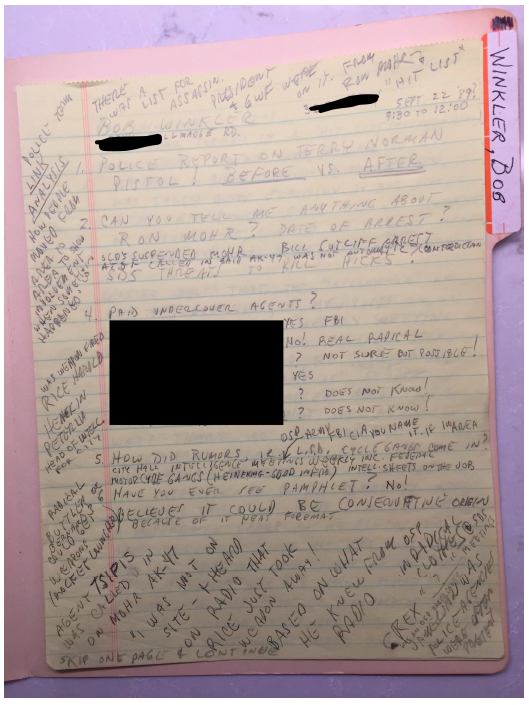
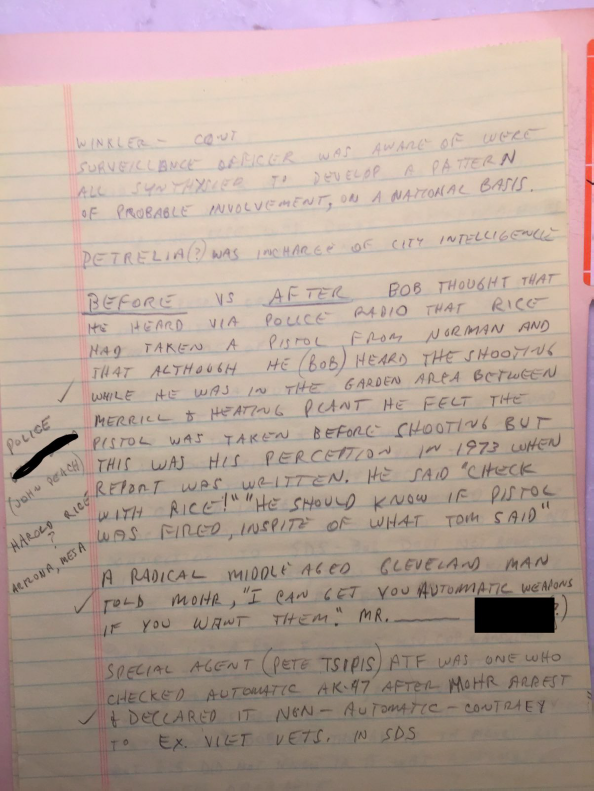

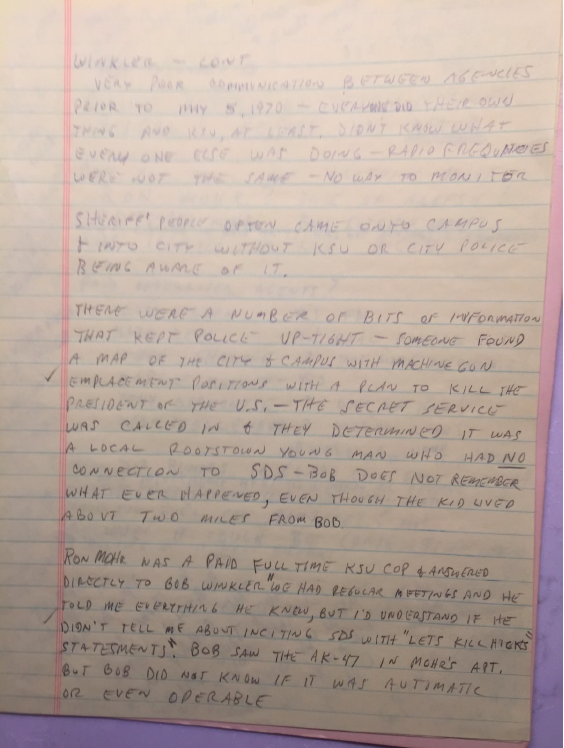
Glenn Frank’s handwritten notes during his phone call with KSU professor Barclay McMillen on Friday November 24, 1989 at 2pm (1 hour phone call):

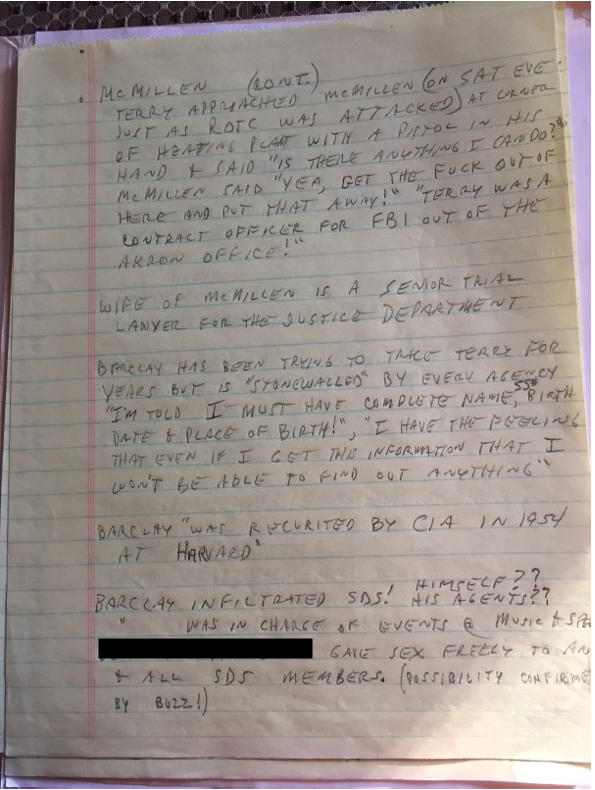
Glenn Frank’s handwritten notes during a second phone call he received from professor Barclay McMillen on Saturday December 24, 1989, at 10am.

According to Glenn Frank’s written notes from his communications with Police Officer Bob Winkler and with Professor Barclay McMillen, both men corroborate the claim that a hit list in relation to the events of May 4, 1970, was created.
The hit list, according to Glenn’s notes, is said to include (himself) Glenn W. Frank and Kent State University President Robert White. While this cannot be proven at this point in time, if such claims were to be true, it suggests the creators of the hit list wanted to keep the truth of May 4th a secret from the public.
*
Memorandum from October 5, 1973. J. Stanley Pottinger Assistant Attorney General of the Civil Rights Division letter to Robert A. Murphy Chief of Criminal Section.
The letter states that Joseph Rhodes, the Governor of Ohio at the time, who ordered the National Guard to Kent State University on May 3, 1970, has been quoted in the past saying “that two guardsmen had gone to Kent State with the intent to shoot at students and that the FBI knew who they were.”

Intelligence Unit Report. The document includes additional information including “At 12:09 on Monday, May 3, 1971, one unidentified female receptionist at Beall-McDowell Hall, contacted this office. Just prior to the call she overheard NBC newsmen state that if trouble did not occur at Kent State University, they would have to create some.” The document was signed by Detective Charles H. Siemer.

Note to readers: Please click the share buttons above or below. Follow us on Instagram, @crg_globalresearch. Forward this article to your email lists. Crosspost on your blog site, internet forums. etc.
Taylor Hudak, MA, is an independent journalist covering human rights abuses in the West, the corruption of the intelligence community and whistleblowing. Taylor’s work can be found on acTVism Munich, YouTube and The Last American Vagabond.
|